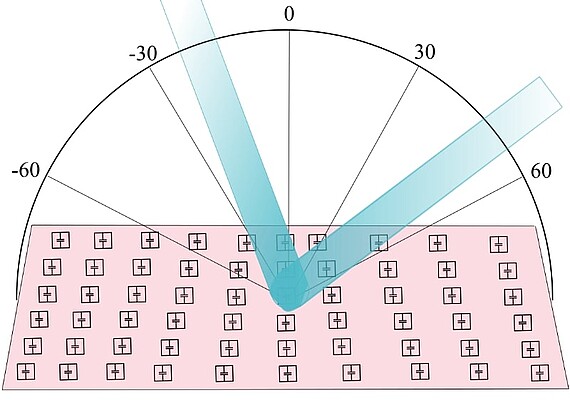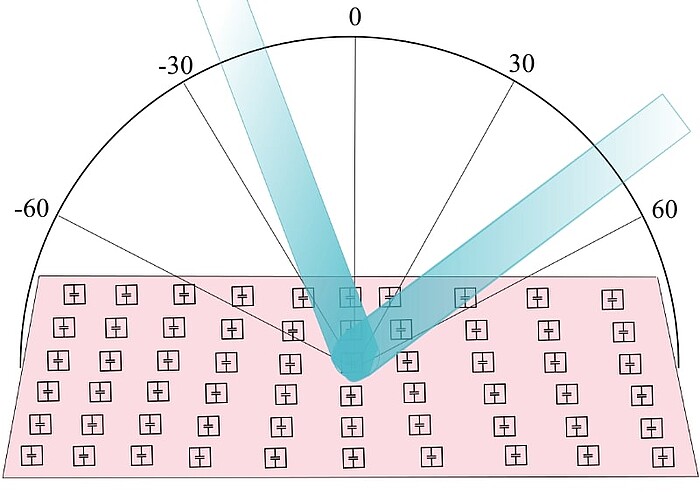


Future radio communication standards beyond 5G are expected to integrate an increasing amount of devices, reaching from the internet of things to consumer devices. This brings challenges as highly populated urban areas have to be covered with high data rates. One completely new feature of these networks of the future is the incorporation of integrated sensing and communication (ISAC). Higher data rates are reached with the use of higher frequencies for the communication. Signals at these higher frequencies attenuate faster and are more easily blocked by buildings, which especially affects communications in urban scenarios.
To reduce these issues in urban environments, Reconfigurable Intelligent Surfaces (RIS) are currently discussed. They are a type of meta-surface that supports reconfigurable reflection of incident signals and thereby enables communication with targets that are blocked from the direct path. RIS can be incorporated into mobile communication channels as a low-cost, low-power addition to basis stations.
Additional examples for meta-surface applications are meta-lenses, which enable manipulation of an incident electromagnetic wave. These meta-lenses can be used to improve properties of existing antenna systems like phased arrays, where they can improve antenna properties such as gain and beamforming capabilities.
Meta-surfaces are quasi-2D structures that enable macroscopic electromagnetic behavior beyond that of a surface made of natural materials by controlling their electromagnetic reflection and refraction properties. This enables for example unusual refraction properties of waves beyond Snell's law and/or dispersion properties of surface waves.
-
Electromagnetic Analysis of Meta-Surfaces
What all meta surfaces have in common is the basis structure in a periodic grid. Therefore, it makes sense to exploit this property for the design and simulation of meta-surfaces.
A periodic structure consists of a basis element, a so-called unit cell that is repeatedly arranged in a lattice. Assuming that the grid vector \(\mathbf{G}_{pq}\) describing the relationship of the unit cells to each other is known, the Floquet theorem can be applied. If the Floquet theorem is applied to a current density \(\mathbf{J}\), the current density distribution of a periodic structure can be described by means of a single unit cell. In \[\mathbf{J}(\mathbf{r}) = \sum\limits_{pq} \hat{j} \cdot \mathrm{e}^{\mathrm{j}\mathbf{G}_{pq} \mathbf{k}_{pq}}\] the Fourier coefficient \(\hat{j}_{pq}\) is called Floquet mode.
Here, the current density depends on the direction \(\mathbf{k}_{pq}\) of the incidence of a plane wave as excitation. This allows the electromagnetic properties of a periodic structure to be analyzed by examining a single unit cell.
One method to analyze the properties of scattering structures are Characteristic Modes computed with the Method of Moments. Therefore, the electric field integral equation (EFIE) has to be adapted for periodicity. Considering the periodicity in the EFIE, the calculated Characteristic Modes can be used as usual in antenna design. -
Application to Reflecting Intelligent Surfaces (RIS)
Reconfigurable Intelligent Surfaces (RIS) are one possible solution to improve wireless connectivity beyond the 5G generation. The use of higher frequencies in these wireless networks requires reliable line-of-sight connections between transmitter and receiver. This line-of-sight can be blocked by buildings in the environment, as seen in the figure.
RIS are meta-surfaces, whose properties can be dynamically set to control the reflection of electromagnetic waves, allowing for anomalous reflection. As the only active components are used for tuning the RIS, it is considered passive from a radiofrequency (RF) standpoint. Having no RF electronics means that RIS are low-cost both in production and operation compared to active equipment. They are therefore seen as a great addition to regular base stations, as they can add additional possibilities to configure the communication channel and by that increase coverage, data rates and more.
The angle of reflection is controlled by the periodicity of the unit-cells. To support different angles, the RIS needs elements able to control the surface.
![Use case of a RIS.]()
![Use case of a RIS.]()
![Use case of a RIS.]()
Fig. 1: Use case of a RIS. -
Application to Meta Lenses
A lens in general is a 3-dimensional object, which manipulates electromagnetic waves. In the optical realm, at least two different kind of lenses are discussed, collective lenses and destructive lens. Meta-Lenses have a wider scope, including polarization manipulation and beam steering. The functionality of a lens is based on different phase velocities in different material and refraction at the border between two materials. For an example, a luneburg lens is given in Fig. 2.
![]()
![]()
![]()
Fig. 2: A Luneburg lens. A luneburg lens is excited on an arbitrary point at the edge. At the opposite end of the lens a plane wave propagates into the space. To achieve this behavior, the refraction coefficients must satisfy the luneburg lens condition. This can be done with different mechanisms.
Meta-Lenses uses unit cells, to manipulate the refractive index to achieve the desired behavior. The question of how shape and periodicity of the unit cells are translated into refractive index and phase velocity is still unanswered and subject of state of the art research, like here in the Institute of Microwave and Wireless Systems.
-
Application to Meta-Surface Antennas
Meta-Surface Antennas differ from the other aspects of meta-surfaces in one distinct point. The structures are directly excited and the excitation is directly integrated into the design. With this commonality very different designs of meta-surface antennas are possible. One popular example of a Meta-Surface Antenna was published by [4] and consists of a monopole antenna as surface wave launcher and a meta-surface for wave manipulation and scattering characteristics. These type of antennas can be beneficial in different aspects, like bandwidth, beam shape and multi beam control.
-
Project ReMoTe
The cooperative project ReMoTe aims at realizing an intelligent reconfigurable surface whose reflection behavior for radio waves in 6G mobile communications can be dynamically adapted to the necessary requirements. In particular, reconfigurable reflecting surfaces are important for the artificial design of communication channels and can be seen as efficient passive repeater. The required passive surface is developed by the Institute of Microwave and Wireless Systems in close coordination with the project partners from industry.
The project ReMoTe is funded by the Federal Ministry of Education and Research. Protection under grant 16KIS1634 within the Innovationspotential klein und mittlere Unternehmen (KMU).
-
References
[1] D. Schurig, J. J. Mock, and D. R. Smith, “Electric-field-coupled resonators for negative permittivity metamaterials,” Appl. Phys. Lett.,vol. 88, no. 4, 2006, Art. no. 041109.
[2] M. Di Renzo et al., "Smart Radio Environments Empowered by Reconfigurable Intelligent Surfaces: How It Works, State of Research, and The Road Ahead," in IEEE Journal on Selected Areas in Communications, vol. 38, no. 11, pp. 2450-2525, Nov. 2020, doi: 10.1109/JSAC.2020.3007211.
[3] A. Hoffmann, D. Manteuffel, “Investigation of Modeling of Anomalous Reflecting Metasurfaces Using Characteristic Modes” 2022 International Workshop on Antenna Technology: Small Antennas, Novel EM Structures and Materials, and Applications (iWAT), 2022
[4] Y. Wen, P. -Y. Qin, S. Maci and Y. J. Guo, "Low-Profile Multibeam Antenna Based on Modulated Metasurface," in IEEE Transactions on Antennas and Propagation, vol. 71, no. 8, pp. 6568-6578, Aug. 2023, doi: 10.1109/TAP.2023.3281677.
Corresponding Lectures
Responsible Research Assistants


30167 Hannover




30167 Hannover




30167 Hannover














